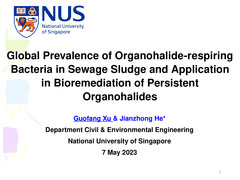Introduction
Halogenated persistent organic pollutants (POPs) have drawn scientific and public attention due to their persistence, toxicity, and bioaccumulation (Jones 2021). Wastewater treatment plants (WWTPs) are indispensable infrastructure in modern society (Wu et al., 2019). Meanwhile, the presence of halogenated POPs in wastewater is well documented, making WWTPs temporary sinks and potential sources of these pollutants (Xu et al., 2022). Despite the widespread occurrence of halogenated POPs in WWTPs, there is a dearth of studies comprehensively evaluating the potential for sewage sludge microbiota to attenuate halogenated POPs. It remains unclear whether organohalide-respiring bacteria (OHRB) that participate in attenuating halogenated POPs in natural environments also function in WWTPs, a better understanding of which would provide insight into the fate of POPs in WWTPs and inform the development of technologies to enable WWTPs to mitigate the emission of POPs. Furthermore, it awaits investigation whether sewage sludge could be utilized to remediate POPs-contaminated soil.
Results and Discussion
Global distribution of putative organohalide-respiring bacteria in wastewater treatment plants. The presence and abundance of putative obligate OHRB in WWTPs were investigated by mining of 1186 sewage sludge microbiomes from 269 globally distributed WWTPs. Approximately half (605 of 1186) of the sewage sludge samples were found to contain at least one putative OHRB population; the average relative abundance of putative OHRB in all samples was 0.006%. Relative abundance of OHRB was positively correlated with precipitation, mixed liquor suspended solids, liquid temperature, solids retention time, hydraulic retention time, and influent industrial wastewater ratio (
r = 0.08−0.28,
p ≤ 0.05) and negatively correlated with food-to-microorganism ratio, influent BOD, and absolute latitude (
r = -0.08−-0.24,
p ≤ 0.05).
Attenuation of halogenated POPs by sewage sludge microbiota via microbial reductive dehalogenation. The high prevalence of putative OHRB in sewage sludge suggests that sewage sludge from geographically disparate locations might be capable of dehalogenating halogenated POPs. To test this, 168 microcosms were established using 84 sewage sludge collected from 38 municipal WWTPs. Following incubation for 6 months, 95% (80 of 84) of sludge microcosms showed PCB dechlorination activity, removing 19.0±7.9 µM chlorine from PCBs and decreasing the average chlorine per PCB from 6.40±0.01 to 6.04±0.15. Like the near-ubiquitous detection of PCB dechlorination, debromination of penta-BDEs was found in 97.6% (82 of 84) sludge microcosms, decreasing the average bromine per PBDE from 4.74±0.01 to 3.57±0.65.
Involvement of diverse known and novel organohalide-respiring bacteria in detoxifying POPs. To identify OHRB involved in PCBs and PBDEs dehalogenation, abundances of three well-characterized OHRB genera (
Dehalococcoides,
Dehalogenimonas, and
Dehalobacter) were enumerated by qPCR following cultivation for 6 months. In general, the abundance of
Dehalococcoides was significantly higher than that of both
Dehalogenimonas and
Dehalobacter in the PCB-dechlorinating microcosms (median 1.4×10
6, 1.4×10
5, and 6.9×10
3 cells/mL, respectively,
p < 0.05). For the penta-BDE debrominating microcosms, the abundances of
Dehalococcoides and
Dehalogenimonas were comparable (2.1×10
6 and 3.8×10
6 cells/mL, respectively), and both were significantly more abundant than
Dehalobacter (1.4×10
4 cells/mL). In addition, several uncultivated Dehalococcoidia were identified in the dehalogenating microcosms. Among these uncultivated Dehalococcoidia populations, the relative abundances of DscP2, S085, t0.6.f, and vadinBA26 were positively correlated with PCB dechlorination (
r = 0.30−0.33,
p < 0.05), whereas the relative abundance of GIF9 and vadinBA26 showed positive correlations (
r = 0.24−0.37,
p < 0.05) with PBDE debromination. These results collectively suggest the involvement of diverse OHRB populations in dehalogenation of PCBs and PBDEs in sewage sludge.
Linking microbial community to attenuation of POPs. The overall diversity of microbial communities was positively correlated (
r = 0.38−0.50,
p < 0.01) with dehalogenation activity. Co-occurrence network analysis showed a positive relationship between network complexity and removal of halogenated substituents from PCBs and PBDEs, however, this relationship broke down in the networks with the highest degrees of complexity. These results indicate that, on top of OHRB abundance, the overall microbial diversity and networks also affect the dehalogenation activity of PCBs and PBDEs in sludge microcosms.
Accelerated bioremediation of PCBs in soil via sewage sludge amendment. We further tested the feasibility of using sewage sludge to bioremediate PCBs-contaminated soil. Results showed that amendment of fresh sewage sludge enhanced the attenuation of PCBs by 126-544% in soil. Microbial and physicochemical analyses revealed that the enhanced dechlorination of PCBs by sludge amendment was attributed to the synergistic effects of sludge-derived nutrients, OHRB, and stimulated growth of beneficial microorganisms (e.g., fermenters). Finally, risk assessment of heavy metals suggested low potential ecological risks of sludge amendment in soil.
Conclusions
- Sewage sludge widely contain putative OHRB, particularly uncultivated Dehalococcoidia, at the globe scale.
- Sewage sludge microbiota extensively dehalogenate PCBs and PBDEs, and known as well as novel OHRB populations were involved in dehalogenation,
- The overall microbial community diversity and networks are also linked with dehalogenation activity.
- Sewage sludge amendment is an effective approach to bioremediate soil polluted by PCBs.






发表评论